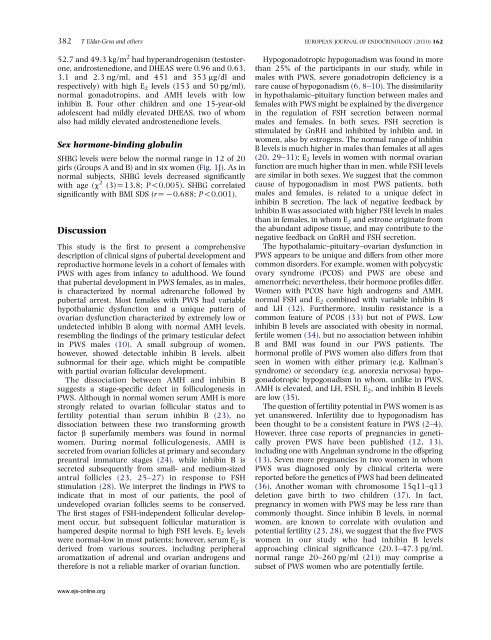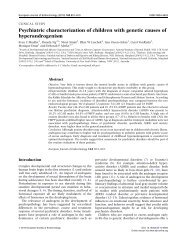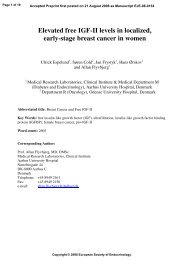Hypogonadism in females with Prader–Willi syndrome from infancy ...
Hypogonadism in females with Prader–Willi syndrome from infancy ...
Hypogonadism in females with Prader–Willi syndrome from infancy ...
Create successful ePaper yourself
Turn your PDF publications into a flip-book with our unique Google optimized e-Paper software.
382 T Eldar-Geva and others EUROPEAN JOURNAL OF ENDOCRINOLOGY (2010) 162<br />
52.7 and 49.3 kg/m 2 had hyperandrogenism (testosterone,<br />
androstenedione, and DHEAS were 0.96 and 0.63,<br />
3.1 and 2.3 ng/ml, and 451 and 353 mg/dl and<br />
respectively) <strong>with</strong> high E 2 levels (153 and 50 pg/ml),<br />
normal gonadotrop<strong>in</strong>s, and AMH levels <strong>with</strong> low<br />
<strong>in</strong>hib<strong>in</strong> B. Four other children and one 15-year-old<br />
adolescent had mildly elevated DHEAS, two of whom<br />
also had mildly elevated androstenedione levels.<br />
Sex hormone-b<strong>in</strong>d<strong>in</strong>g globul<strong>in</strong><br />
SHBG levels were below the normal range <strong>in</strong> 12 of 20<br />
girls (Groups A and B) and <strong>in</strong> six women (Fig. 1J). As <strong>in</strong><br />
normal subjects, SHBG levels decreased significantly<br />
<strong>with</strong> age (c 2 (3)Z13.8; P!0.005). SHBG correlated<br />
significantly <strong>with</strong> BMI SDS (rZK0.688; P!0.001).<br />
Discussion<br />
This study is the first to present a comprehensive<br />
description of cl<strong>in</strong>ical signs of pubertal development and<br />
reproductive hormone levels <strong>in</strong> a cohort of <strong>females</strong> <strong>with</strong><br />
PWS <strong>with</strong> ages <strong>from</strong> <strong>in</strong>fancy to adulthood. We found<br />
that pubertal development <strong>in</strong> PWS <strong>females</strong>, as <strong>in</strong> males,<br />
is characterized by normal adrenarche followed by<br />
pubertal arrest. Most <strong>females</strong> <strong>with</strong> PWS had variable<br />
hypothalamic dysfunction and a unique pattern of<br />
ovarian dysfunction characterized by extremely low or<br />
undetected <strong>in</strong>hib<strong>in</strong> B along <strong>with</strong> normal AMH levels,<br />
resembl<strong>in</strong>g the f<strong>in</strong>d<strong>in</strong>gs of the primary testicular defect<br />
<strong>in</strong> PWS males (10). A small subgroup of women,<br />
however, showed detectable <strong>in</strong>hib<strong>in</strong> B levels, albeit<br />
subnormal for their age, which might be compatible<br />
<strong>with</strong> partial ovarian follicular development.<br />
The dissociation between AMH and <strong>in</strong>hib<strong>in</strong> B<br />
suggests a stage-specific defect <strong>in</strong> folliculogenesis <strong>in</strong><br />
PWS. Although <strong>in</strong> normal women serum AMH is more<br />
strongly related to ovarian follicular status and to<br />
fertility potential than serum <strong>in</strong>hib<strong>in</strong> B (23), no<br />
dissociation between these two transform<strong>in</strong>g growth<br />
factor b superfamily members was found <strong>in</strong> normal<br />
women. Dur<strong>in</strong>g normal folliculogenesis, AMH is<br />
secreted <strong>from</strong> ovarian follicles at primary and secondary<br />
preantral immature stages (24), while <strong>in</strong>hib<strong>in</strong> B is<br />
secreted subsequently <strong>from</strong> small- and medium-sized<br />
antral follicles (23, 25–27) <strong>in</strong> response to FSH<br />
stimulation (28). We <strong>in</strong>terpret the f<strong>in</strong>d<strong>in</strong>gs <strong>in</strong> PWS to<br />
<strong>in</strong>dicate that <strong>in</strong> most of our patients, the pool of<br />
undeveloped ovarian follicles seems to be conserved.<br />
The first stages of FSH-<strong>in</strong>dependent follicular development<br />
occur, but subsequent follicular maturation is<br />
hampered despite normal to high FSH levels. E 2 levels<br />
were normal-low <strong>in</strong> most patients; however, serum E 2 is<br />
derived <strong>from</strong> various sources, <strong>in</strong>clud<strong>in</strong>g peripheral<br />
aromatization of adrenal and ovarian androgens and<br />
therefore is not a reliable marker of ovarian function.<br />
Hypogonadotropic hypogonadism was found <strong>in</strong> more<br />
than 25% of the participants <strong>in</strong> our study, while <strong>in</strong><br />
males <strong>with</strong> PWS, severe gonadotrop<strong>in</strong> deficiency is a<br />
rare cause of hypogonadism (6, 8–10). The dissimilarity<br />
<strong>in</strong> hypothalamic–pituitary function between males and<br />
<strong>females</strong> <strong>with</strong> PWS might be expla<strong>in</strong>ed by the divergence<br />
<strong>in</strong> the regulation of FSH secretion between normal<br />
males and <strong>females</strong>. In both sexes, FSH secretion is<br />
stimulated by GnRH and <strong>in</strong>hibited by <strong>in</strong>hib<strong>in</strong> and, <strong>in</strong><br />
women, also by estrogens. The normal range of <strong>in</strong>hib<strong>in</strong><br />
B levels is much higher <strong>in</strong> males than <strong>females</strong> at all ages<br />
(20, 29–31); E 2 levels <strong>in</strong> women <strong>with</strong> normal ovarian<br />
function are much higher than <strong>in</strong> men, while FSH levels<br />
are similar <strong>in</strong> both sexes. We suggest that the common<br />
cause of hypogonadism <strong>in</strong> most PWS patients, both<br />
males and <strong>females</strong>, is related to a unique defect <strong>in</strong><br />
<strong>in</strong>hib<strong>in</strong> B secretion. The lack of negative feedback by<br />
<strong>in</strong>hib<strong>in</strong> B was associated <strong>with</strong> higher FSH levels <strong>in</strong> males<br />
than <strong>in</strong> <strong>females</strong>, <strong>in</strong> whom E 2 and estrone orig<strong>in</strong>ate <strong>from</strong><br />
the abundant adipose tissue, and may contribute to the<br />
negative feedback on GnRH and FSH secretion.<br />
The hypothalamic–pituitary–ovarian dysfunction <strong>in</strong><br />
PWS appears to be unique and differs <strong>from</strong> other more<br />
common disorders. For example, women <strong>with</strong> polycystic<br />
ovary <strong>syndrome</strong> (PCOS) and PWS are obese and<br />
amenorrheic; nevertheless, their hormone profiles differ.<br />
Women <strong>with</strong> PCOS have high androgens and AMH,<br />
normal FSH and E 2 comb<strong>in</strong>ed <strong>with</strong> variable <strong>in</strong>hib<strong>in</strong> B<br />
and LH (32). Furthermore, <strong>in</strong>sul<strong>in</strong> resistance is a<br />
common feature of PCOS (33) but not of PWS. Low<br />
<strong>in</strong>hib<strong>in</strong> B levels are associated <strong>with</strong> obesity <strong>in</strong> normal,<br />
fertile women (34), but no association between <strong>in</strong>hib<strong>in</strong><br />
B and BMI was found <strong>in</strong> our PWS patients. The<br />
hormonal profile of PWS women also differs <strong>from</strong> that<br />
seen <strong>in</strong> women <strong>with</strong> either primary (e.g. Kallman’s<br />
<strong>syndrome</strong>) or secondary (e.g. anorexia nervosa) hypogonadotropic<br />
hypogonadism <strong>in</strong> whom, unlike <strong>in</strong> PWS,<br />
AMH is elevated, and LH, FSH, E 2 , and <strong>in</strong>hib<strong>in</strong> B levels<br />
are low (35).<br />
The question of fertility potential <strong>in</strong> PWS women is as<br />
yet unanswered. Infertility due to hypogonadism has<br />
been thought to be a consistent feature <strong>in</strong> PWS (2–4).<br />
However, three case reports of pregnancies <strong>in</strong> genetically<br />
proven PWS have been published (12, 13),<br />
<strong>in</strong>clud<strong>in</strong>g one <strong>with</strong> Angelman <strong>syndrome</strong> <strong>in</strong> the offspr<strong>in</strong>g<br />
(13). Seven more pregnancies <strong>in</strong> two women <strong>in</strong> whom<br />
PWS was diagnosed only by cl<strong>in</strong>ical criteria were<br />
reported before the genetics of PWS had been del<strong>in</strong>eated<br />
(36). Another woman <strong>with</strong> chromosome 15q11–q13<br />
deletion gave birth to two children (37). In fact,<br />
pregnancy <strong>in</strong> women <strong>with</strong> PWS may be less rare than<br />
commonly thought. S<strong>in</strong>ce <strong>in</strong>hib<strong>in</strong> B levels, <strong>in</strong> normal<br />
women, are known to correlate <strong>with</strong> ovulation and<br />
potential fertility (23, 28), we suggest that the five PWS<br />
women <strong>in</strong> our study who had <strong>in</strong>hib<strong>in</strong> B levels<br />
approach<strong>in</strong>g cl<strong>in</strong>ical significance (20.3–47.3 pg/ml,<br />
normal range 20–260 pg/ml (21)) may comprise a<br />
subset of PWS women who are potentially fertile.<br />
www.eje-onl<strong>in</strong>e.org









